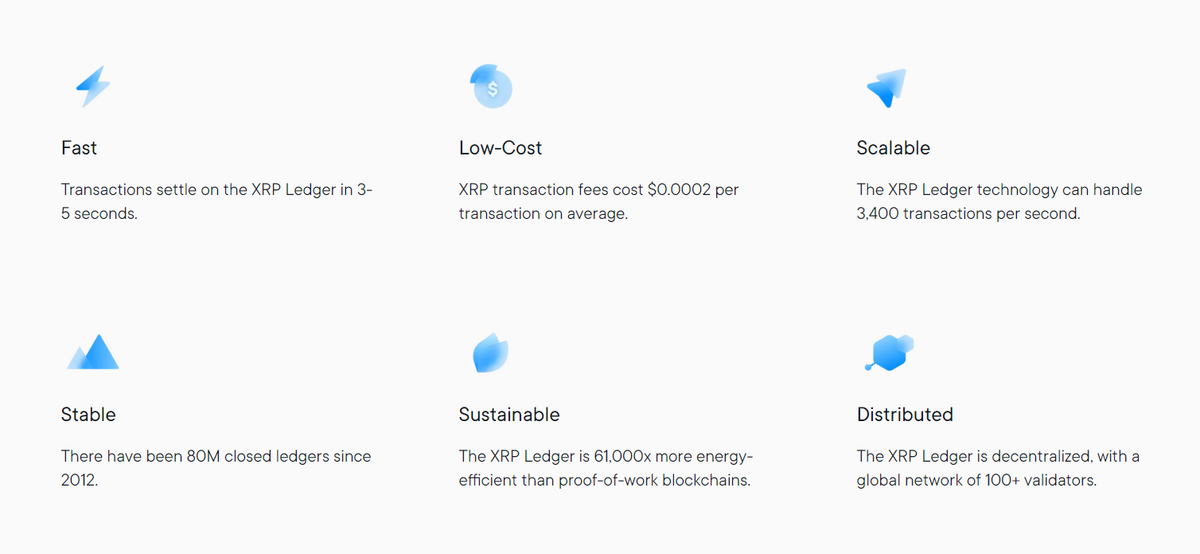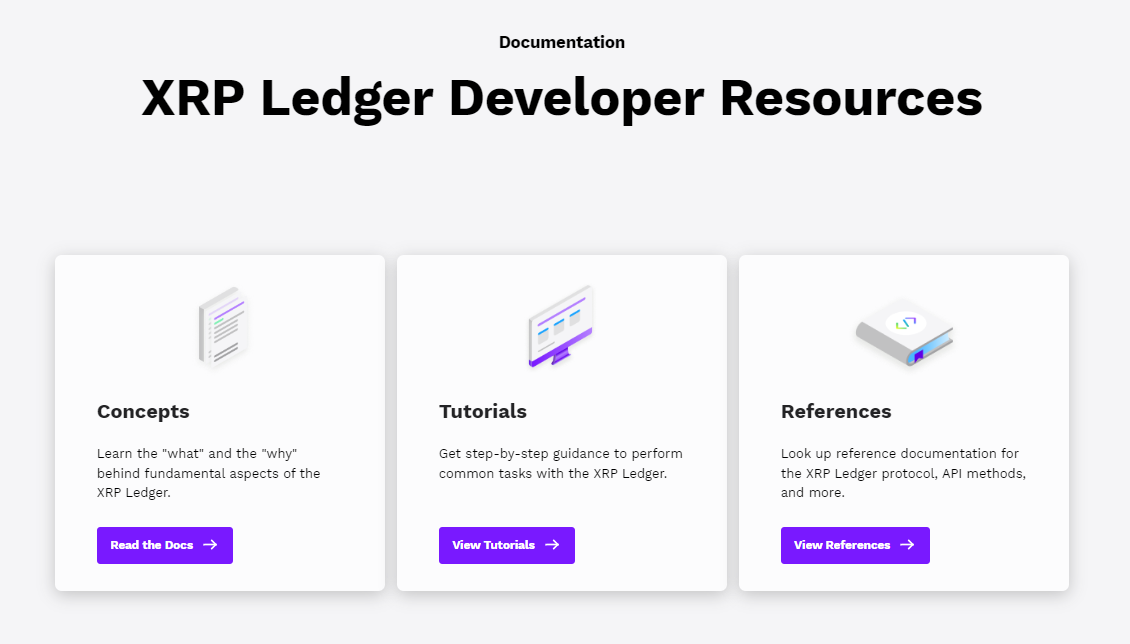
With the bulk of XRP’s long-standing legal battle with the U.S. Securities and Exchange Commission (SEC) in the rearview mirror, Ripple developers can turn their undivided attention to the growth of the blockchain itself.
Despite its high position in the crypto market, the XRP Ledger doesn’t actually support a great range of applications. Its DeFi and NFT scene is remarkably small, especially compared to Layer 1 blockchains like Ethereum (ETH) or Cardano (ADA).
Is the XRP Ledger a good environment for blockchain development? Where can Ripple developers learn more about the platform and begin positively contributing to the network?
Table of Contents
Benefits of the XRP Ledger
The XRP Ledger is the underlying technology behind Ripple’s revolutionary cross-border payments network. Capable of streamlining international transactions and facilitating the improved flow of funds across the planet, the XRP Ledger has proven popular amongst financial institutions like Santander Bank.
Sponsored
Unlike its predecessor, Bitcoin (BTC), the XRP Ledger boasts a highly scalable network. Estimated to be 61,000 times more energy efficient than the original Proof-of-Work blockchain, the XRP Ledger can process up to 3,400 transactions per second.

Better yet, every XRPL transaction requires an average fee of only $0.0002, improving it considerably over the existing methods we see in traditional cross-border payments.
Sponsored
On paper, these metrics give us a fast blockchain network that is energy-efficient and affordable to use. While this should mean that the XRP Ledger already has a thriving ecosystem of applications, this is far from the reality.
Why Has Nothing Been Built on Ripple’s XRP Ledger?
Compared with alternative networks, the XRP Ledger is void of activity. Users can send and receive XRP tokens within seconds at a minimal fee, but the network lacks the vast range of products and services that we would expect from other blockchains.
However, this all might be about to change. One of the biggest obstacles to developer adoption on the XRPL is that the network doesn’t support smart contract development. This dramatically reduces its potential use cases.
According to XRPL Labs expert WiesteWind, the belief that the XRP Ledger cannot support composable activity is a myth. He argues that there’s a great deal of misinformation and controversy around the XRPL, and it is, in fact, prepared and capable of supporting a wider variety of tools and applications.
WiesteWind claims that the lack of knowledge and education about what the XRPL offers has discouraged builders and developers from using the protocol. By addressing this misunderstanding, the XRP community should help onboard new Ripple developers to the ecosystem and help expand the network’s offering.
Becoming a Ripple Developer
Fortunately for all the budding blockchain developers, Ripple Labs has crafted comprehensive official documentation outlining the ins and outs of XRPL development.
Ripple’s developer docs provide plenty of context around the XRP Ledger’s unique properties and vision and offer practical step-by-step tutorials that educate beginners and help them perform common tasks on the XRPL.

It’s worth mentioning, however, that prospective developers should already have some experience in computer science. Blockchain development is a rather complex fork of this field, and beginners should acquaint themselves with easier aspects before diving into the deep end.
Before tinkering around with Ripple’s toolkits, developers should understand programming languages like JavaScript, Python, and C++.
Where to Find Ripple Developer Resources?
Blockchain enthusiasts eager to start building new projects on the XRP Ledger need look no further than the official Ripple developer documentation. This comprehensive resource offers everything developers need to build meaningful applications that the XRPL desperately misses.
The documentation also offers links to Ripple testnet faucets, which provide developers with the test network XRP tokens required to build applications safely in a sandbox environment.
The Ripple Developer Community
Alongside the extensive resources, tutorials, and SDKs (Software Development Kits), the developer docs also provide links to the official Ripple developer community.
If you’re considering building innovative new applications on the XRP Ledger, joining link-minded Ripple enthusiasts is an excellent step in the right direction. You’ll be able to bounce ideas off experts and solve any problems.
On top of that, you’ll be able to submit your startup ideas for ecosystem grants and hackathons. Blockchain-based solutions are expected to witness dramatically increased demand in the coming years, and the XRP Ledger needs creative apps to help it compete with modern blockchain networks.
Ripple Developer Events
By joining the Ripple developer community, you’ll be kept up to date not only on what’s happening on-chain but also in the real world. The Ripple developer community is worldwide and frequently hosts events and conferences that bring XRPL contributors together.
This can be a great way to network with other XRP enthusiasts and Ripple developers and stay abreast of XRP’s latest updates and progress reports.
Key Ripple Developers
Ripple Labs has a long history, with a great variety of developers contributing to the success of the crypto project. Who are some of the key contributors to the XRP Ledger?
David Schwartz
The current Ripple Labs CTO (Chief Technology Officer), David Schwartz, is Ripple developers’ head honcho. Schwartz leads the Ripple development team from the front, but his work extends beyond coding and programming all day.
The Ripple Labs CTO is an outspoken voice amongst the XRP community. He frequently attends conferences and events, helping to shed light on new technologies and functions within the XRP Ledger. He’s also fairly active on social media and is quick to share his thoughts and opinions on evolving trends and narratives in the Ripple ecosystem.
Jed McCaleb
Jed McCaleb’s name is somewhat tarnished within the XRP community, thanks to his dramatic exit from the cryptocurrency project in its early days. He left Ripple in 2013 to launch a rival blockchain, Stellar (XLM).
Despite this, McCaleb was one of the original XRP founders. Alongside David Schwartz, he served as one of the cryptocurrency project’s chief architects and is largely responsible for the XRP Ledger as it exists today.
On the Flipside
- Ripple Labs, and by extension, the XRP Ledger, are one of the oldest teams and platforms in the crypto space. But despite their experience, the XRP Ledger is still well behind modern blockchains in terms of functionality.
Why This Matters
Ripple developers are in high demand, but there are still lingering concerns and misunderstandings about what the XRP Ledger is capable of.
FAQs
Ripple Labs is a private company responsible for managing the XRP Ledger and its international network of financial institutions.
Ripple was originally developed and created by David Schwartz and Jed McCaleb, although McCaleb left the project shortly after launch.
According to Electric Capital, Ripple has 39 full-time developers and over 170 developers demonstrating monthly activity.
